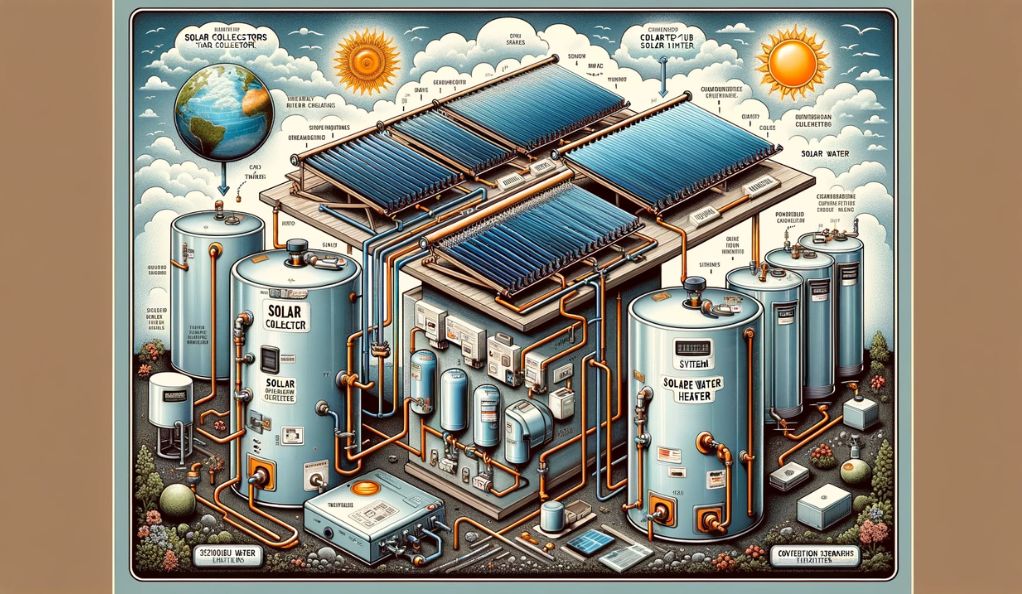Introduction
Harnessing solar energy for efficient and sustainable home water heating. These systems consist of collectors and a storage tank, using sunlight to heat water. Active and passive systems are the two main types, with active systems employing pumps and passive ones relying on natural convection.
In sunny climates, solar water heaters reduce reliance on traditional energy sources, cutting utility costs and lowering carbon footprints. Technological advancements have made these systems more efficient and affordable. They can easily integrate with existing hot water setups, making them accessible to more homeowners. As environmental concerns grow and traditional energy costs rise, solar water heating adoption is increasing, promoting sustainable living.
Types of Solar Water Heaters
Solar water heating systems can be broadly classified into two categories: active and passive. Active solar water heaters use pumps and control systems to circulate water or a heat-transfer fluid through the collectors. They are further divided into direct circulation systems, ideal for climates where freezing is rare, and indirect circulation systems, suitable for areas with freezing temperatures.
On the other hand, passive solar water heaters rely on natural circulation of water due to heat-induced density changes. These systems are generally more affordable and less complex than active systems but are often less efficient. Integral collector-storage passive systems and thermosyphon systems are common types of passive solar water heaters. The former is suitable for areas that do not experience freezing temperatures and is effective for households with significant hot water needs throughout the day, while the latter relies on the principle of warm water rising and is effective in a variety of climate conditions.
Components of a Solar Water Heating System

The key components of a solar water heating system include solar collectors and storage tanks. Solar collectors capture and convert sunlight into heat, and are of three main types: flat-plate collectors, integral collector-storage systems, and evacuated-tube solar collectors. Storage tanks hold the heated water and are crucial for the system’s efficiency. They are often equipped with additional outlets and inlets for integration with the solar collector.
In two-tank systems, solar water heaters preheat water before it enters a conventional water heater, while in one-tank systems, the backup heater is combined with the solar storage in one tank. These systems almost always require a backup system for cloudy days and times of increased demand, with conventional storage water heaters often serving this purpose.
Benefits of Solar Water Heating in Homes
The benefits of installing a solar water heating system in a home are manifold. Firstly, they are a cost-effective solution for reducing energy bills, as solar energy is free and abundant. Secondly, these systems are environmentally friendly, reducing the carbon footprint of a household by decreasing dependence on fossil fuels. Additionally, solar water heaters have a long lifespan and require relatively low maintenance, making them a practical long-term investment for homeowners.
Installation and Maintenance Insights
Installing a solar water heating system requires careful planning and consideration of several factors. The orientation and tilt of the solar panels, for instance, are critical to maximizing solar exposure. Professional installation is recommended to ensure optimal performance and adherence to local building codes and regulations. Maintenance of these systems, while generally low, is crucial for long-term efficiency. Periodic checks of the system components, such as the pumps, valves, and solar collectors, are necessary to maintain optimal performance.
Evaluating Your Home for Solar Water Heating
Assessing your home’s suitability for a solar water heating system involves evaluating the solar resource, roof structure, and space for the storage tank. The system size should align with your household’s hot water needs, factoring in the number of occupants and typical usage patterns. A thorough site evaluation by a professional can help determine the most suitable system type and size for your home, ensuring maximum efficiency and cost-effectiveness.
Future Trends and Innovations in Solar Water Heating
The future of solar water heating systems is promising, with ongoing innovations aimed at increasing efficiency and reducing costs. Emerging trends include the integration of advanced materials for better heat absorption and storage, smart technology for system monitoring and control, and hybrid systems that combine solar heating with other renewable energy sources. These advancements promise to make solar water heating an even more attractive option for homeowners seeking sustainable and efficient solutions for their hot water needs.
Conclusion
Adopting solar water heating systems in homes marks a significant step towards sustainable living. These systems not only offer an eco-friendly solution for hot water needs but also provide long-term financial benefits through reduced energy bills. With advancements in technology, solar water heaters have become more efficient and accessible. As the world increasingly focuses on renewable energy, homeowners have a unique opportunity to contribute positively to this global shift. By choosing solar water heating, individuals can enjoy the dual benefits of environmental responsibility and economic savings, making it a wise choice for those looking to make a difference both in their homes and the planet.
